Really, I’m fine with you watering it down: Part II: Blue Valentine, A Film Unfinished, and Red
Continued from here:
 Sometimes the watering down of a movie is not from within, but the film gets punished for its honesty and direct emotion. Such is the case with Derek Cianfrance’s Blue Valentine which received a bewildering NC-17 from the MPAA for, well, because Michelle Williams has a realistic orgasm on screen. The MPAA is notoriously harsh on female pleasure, at least the kind that isn’t man slams woman against the bathroom stall (or a wall) and they both finish, with their pants on, in 4 seconds. In other words, Highlander II: The Quickening is more appropriate for teenagers. In Blue Valentine’s case, the sex is oral, and there’s no visible nudity during the sequence, let alone any reasonable feeling that the scene is anything other than simulated.
Sometimes the watering down of a movie is not from within, but the film gets punished for its honesty and direct emotion. Such is the case with Derek Cianfrance’s Blue Valentine which received a bewildering NC-17 from the MPAA for, well, because Michelle Williams has a realistic orgasm on screen. The MPAA is notoriously harsh on female pleasure, at least the kind that isn’t man slams woman against the bathroom stall (or a wall) and they both finish, with their pants on, in 4 seconds. In other words, Highlander II: The Quickening is more appropriate for teenagers. In Blue Valentine’s case, the sex is oral, and there’s no visible nudity during the sequence, let alone any reasonable feeling that the scene is anything other than simulated.
The reason this is relevant to the film is because I had no idea of the ratings controversy going into the film, I was informed afterward, and it stunned me because I was not only confused by any possible reasoning behind it, but because I thought it was a shame that Cianfrance would have to cut any of his brutally honest, direct, and realistic film.
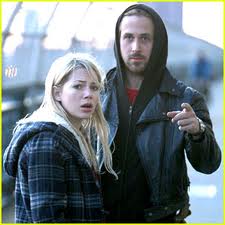 And like the rating, as a movie, Blue Valentine is sneaky. It begins with Michelle Williams and a balding Ryan Gosling slumming in Indie Movie Cliché hell, where hicks talk about living “in the middle of nowheres.” It seems like we’re somewhere in the Midwest in accent and attitude (turns out it was rural Pennsylvania, close enough), and we’re watching an acting exercise drawn out to feature length. The movie feels like it’s going Meta when we then see a younger looking Gosling, full head of hair, Brooklyn accent, and surface-slick. Is he going to work on an Indie movie, and this is right before he gets to the makeup chair to have his hairline moved back and hideous driving glasses added?
And like the rating, as a movie, Blue Valentine is sneaky. It begins with Michelle Williams and a balding Ryan Gosling slumming in Indie Movie Cliché hell, where hicks talk about living “in the middle of nowheres.” It seems like we’re somewhere in the Midwest in accent and attitude (turns out it was rural Pennsylvania, close enough), and we’re watching an acting exercise drawn out to feature length. The movie feels like it’s going Meta when we then see a younger looking Gosling, full head of hair, Brooklyn accent, and surface-slick. Is he going to work on an Indie movie, and this is right before he gets to the makeup chair to have his hairline moved back and hideous driving glasses added?
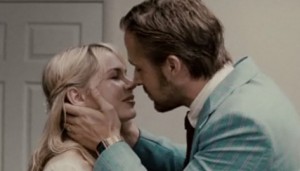 Whether the misdirection is purposeful or not Blue Valentine is all about structure, and it’s soon we realize that we’re seeing characters at two different points in their lives, right before they meet and become a couple and just as their relationship is coming to an end, and they’re going to meet in the middle (think Francois Ozon’s 5×2 which shows the same couple at 5 different key points in their relationship). Narrative deception is not usually the recipe for thoughtful writing and three dimensional characters, the only film that effectively develops its characters as they react to the frequent plot twists is Sam Raimi’s A Simple Plan.
Whether the misdirection is purposeful or not Blue Valentine is all about structure, and it’s soon we realize that we’re seeing characters at two different points in their lives, right before they meet and become a couple and just as their relationship is coming to an end, and they’re going to meet in the middle (think Francois Ozon’s 5×2 which shows the same couple at 5 different key points in their relationship). Narrative deception is not usually the recipe for thoughtful writing and three dimensional characters, the only film that effectively develops its characters as they react to the frequent plot twists is Sam Raimi’s A Simple Plan.
Cianfrance’s approach is more subtle though; Michelle Williams goes from tired, beaten down woman to six or seven years earlier, where she still has the little girl look in her eyes that she always does, but sprightly, ambitious, attractive co-ed. The only difference might be that she’s wearing better make-up as a college student, but the performances are significantly different enough to be believable as older and younger versions of the same person. Gosling pulls an even neater trick because initially, he is very unsympathetic, using their child against her, and trying to guilt Williams into joining him at a sleazy motel to try to re-invigorate their dissipating relationship. But as we learn more information about their past together, who is using who becomes unclear, and his acceptance of his own intellectual limitations paves the way for insight into how she might have stolen his life from him and is going to take it away a second time, what’s left of it anyway, in the present day scenes.
 Gosling becomes a charmer with a sense of humor (when she asks him who he thinks she saw at the liquor store he says, “Richard Greico?”) and she looks like the selfish, silver-spooned girl, repeatedly asking him to make sacrifices, something she’s not willing to do. It’s hard to imagine the threat of domestic violence towards a women being twisted in this way, but you certainly feel for Gosling and find Williams deserving of his wrath, if not his physical punishment. Blue Valentine plays with our own expectations and assumptions of stereotypes enough to re-think the film at several different parts, and the movie gets more moving and sad as it reveals its many layers. It would be a true shame if Cianfrance was forced to cut anything, because his film is so precise and delicate that to censor it would do more than neuter it visually, but emotionally too.
Gosling becomes a charmer with a sense of humor (when she asks him who he thinks she saw at the liquor store he says, “Richard Greico?”) and she looks like the selfish, silver-spooned girl, repeatedly asking him to make sacrifices, something she’s not willing to do. It’s hard to imagine the threat of domestic violence towards a women being twisted in this way, but you certainly feel for Gosling and find Williams deserving of his wrath, if not his physical punishment. Blue Valentine plays with our own expectations and assumptions of stereotypes enough to re-think the film at several different parts, and the movie gets more moving and sad as it reveals its many layers. It would be a true shame if Cianfrance was forced to cut anything, because his film is so precise and delicate that to censor it would do more than neuter it visually, but emotionally too.
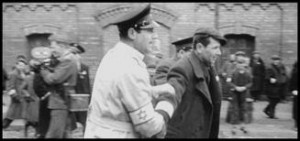 Censorship is at the very heart of Yael Hersonski’s A Film Unfinished which combines the rote drudgery of the Holocaust documentary with the peculiarity of the construction of certain types of propaganda. The movie feels both ill-advised with its Errol Morris-like recreations of those German filmmakers who were commissioned to make an anti-Semitic “documentary” and absolutely necessary as it examines Hitler’s insecurity about his own decisions.
Censorship is at the very heart of Yael Hersonski’s A Film Unfinished which combines the rote drudgery of the Holocaust documentary with the peculiarity of the construction of certain types of propaganda. The movie feels both ill-advised with its Errol Morris-like recreations of those German filmmakers who were commissioned to make an anti-Semitic “documentary” and absolutely necessary as it examines Hitler’s insecurity about his own decisions.
The documentary that the German filmmakers were making was intended to create a very odd juxtaposition, showing the starving Jews in the Warsaw Ghetto (“a large pile of feces in the courtyard”) compared to staged scenes of rich Jews being gluttonous and wasteful. Granted the scenes weren’t supposed to look staged, but what is never made clear in the film is whether or not Hitler directly ordered this specific type of propaganda, or it was arranged by his underlings to convince him that indeed, the Jews should be exterminated, and he was on the right path. Did those in the SS believe in what they were doing, or were they just doing what they were told for fear of being killed. How far up the ladder did the conformity fear go up? Is ignorance the best way to deal with a massacre? Granted such fear is at the heart of all dictatorships, but what happens when no one believes in what they are doing and do it anyway?
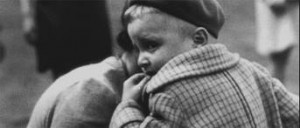 Hersonski’s film tries to scale this wall and is not always successful; it’s burdened by a monotone voiceover by a woman whose voice is always crackling. The footage of the uncompleted documentary, which had no sound and was only in a rough cut form, didn’t need extra gravity; it is shocking enough on its own, especially when we see the outtakes of the staged scenes. Then there’s the sight of dead bodies on the street with the residents so used to it that they just walk past them. The use of a “thriller” score is also a mistake by Hersonski, it makes even the documentary about the documentary feel phony. We’re reminded of other films about unfinished and obviously less historically important films like last year’s Henri-Georges Clouzot’s Inferno (which was eventually superbly made by Claude Chabrol) and the wonderful mockumentary by Peter Jackson, Forgotten Silver.
Hersonski’s film tries to scale this wall and is not always successful; it’s burdened by a monotone voiceover by a woman whose voice is always crackling. The footage of the uncompleted documentary, which had no sound and was only in a rough cut form, didn’t need extra gravity; it is shocking enough on its own, especially when we see the outtakes of the staged scenes. Then there’s the sight of dead bodies on the street with the residents so used to it that they just walk past them. The use of a “thriller” score is also a mistake by Hersonski, it makes even the documentary about the documentary feel phony. We’re reminded of other films about unfinished and obviously less historically important films like last year’s Henri-Georges Clouzot’s Inferno (which was eventually superbly made by Claude Chabrol) and the wonderful mockumentary by Peter Jackson, Forgotten Silver.
A Film Unfinished is caught in a conundrum though, it wants to show how ineffective the propaganda film is, by showing how it was just work to the filmmakers (one of whom later amusingly complains about a lack of directorial auteurism) and they really didn’t care about what they were doing. The final film likely would have been very passive and disjointed, as it offers no particular POV, but then again, A Film Unfinished is mostly told in the passive voice too.
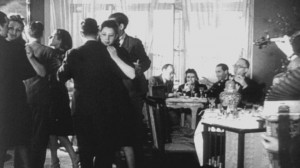 The only scenes that have the horrifying power that Hersonski was after (and make the film worth seeing), have the survivors of the Warsaw Ghetto interviewed as they watch the footage. [“What if I see someone I know?”]. Since there have been so many documentaries about the various atrocities of the Holocaust, A Film Unfinished has to justify itself as more than just punishment for the viewer and wallowing in the suffering (like Shoah), more than the meeting of despair and preservation, more than just a glorified editing session. Otherwise Hersonski could make a sequel about another, more famous Holocaust film that was never finished that the world is curious about, Jerry Lewis’ The Day The Clown Cried.
The only scenes that have the horrifying power that Hersonski was after (and make the film worth seeing), have the survivors of the Warsaw Ghetto interviewed as they watch the footage. [“What if I see someone I know?”]. Since there have been so many documentaries about the various atrocities of the Holocaust, A Film Unfinished has to justify itself as more than just punishment for the viewer and wallowing in the suffering (like Shoah), more than the meeting of despair and preservation, more than just a glorified editing session. Otherwise Hersonski could make a sequel about another, more famous Holocaust film that was never finished that the world is curious about, Jerry Lewis’ The Day The Clown Cried.
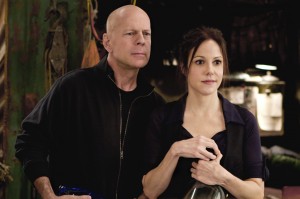 Oh, if Robert Schwentke’s Red were as distinctive and potentially interesting as The Day the Clown Cried. This action-comedy adaptation of the considerably more violent graphic novel about a group of retired CIA agents who have become the agencies top targets, has been tapered to a genial and audience [un]friendly PG-13. Bruce Willis, the lead in the film, is in straight comedy mode, which is troubling for anyone who has seen his self-consciously wacky performances in Hudson Hawk and The Whole Ten Yards or when he shows up on David Letterman’s show. The more Willis lets on that he knows he’s being funny, the more aggravating he becomes.
Oh, if Robert Schwentke’s Red were as distinctive and potentially interesting as The Day the Clown Cried. This action-comedy adaptation of the considerably more violent graphic novel about a group of retired CIA agents who have become the agencies top targets, has been tapered to a genial and audience [un]friendly PG-13. Bruce Willis, the lead in the film, is in straight comedy mode, which is troubling for anyone who has seen his self-consciously wacky performances in Hudson Hawk and The Whole Ten Yards or when he shows up on David Letterman’s show. The more Willis lets on that he knows he’s being funny, the more aggravating he becomes.
The rest of Red is a glib, self-congratulatory, nudge-nudge, suck-up, forgettable annoyance. As I mentioned in my interview with Red’s villain Karl Urban, the film is mostly shot in daytime (in reds and whites), and it has a very distinctive look. A look of being ugly and unpleasant. It’s a shame because Urban’s character (a ringer for Johnny Knoxville) is by far the most interesting; he’s a villain with a real family, who is admittedly just doing his job. Watching Willis, Morgan Freeman, Mary-Louise Parker (making flirty fish faces at Willis), Brian Cox, John Malkovich, and Helen Mirren ham it up makes you start rooting for Urban.
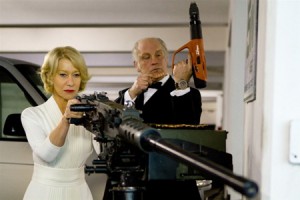 The fact that the movie can’t go two minutes without characters pointing guns at each other (but rarely using them, the threat becomes tiresome) highlights its lack of imagination even within its own genre. There aren’t even any established rules in Red; no character is too dead to come back to life a few minutes later. Sure, the movie is supposed to be a cartoon (“I’m the bad guy, remember?”), outlined by Malkovich’s burned out gun nut, who talks like Walter Sobchak (John Goodman in The Big Lebowski), and is always conveniently lucid when he isn’t over-the-top crazy, but there has to be something at stake for us to care.
The fact that the movie can’t go two minutes without characters pointing guns at each other (but rarely using them, the threat becomes tiresome) highlights its lack of imagination even within its own genre. There aren’t even any established rules in Red; no character is too dead to come back to life a few minutes later. Sure, the movie is supposed to be a cartoon (“I’m the bad guy, remember?”), outlined by Malkovich’s burned out gun nut, who talks like Walter Sobchak (John Goodman in The Big Lebowski), and is always conveniently lucid when he isn’t over-the-top crazy, but there has to be something at stake for us to care.
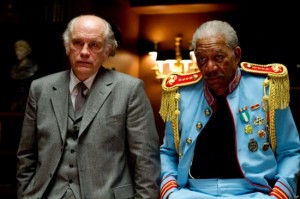 The theme of aging action stars is a way of grounding the film (much like in the equally silly summer movies Knight and Day and The Expendables), but this is just an excuse for more mugging and lame jokes about basically being too old for this shit. Does a movie like Red need to be more substantial, considering it is bound to be forgotten within hours of its release? No, but its very insubstantiality was created by the tone, constantly trying to reassure the audience that everything is going to be okay. No one gets hurt, okay? See? He’s just faking his death. Now let’s get you some cocoa and a DVD of Miss Congeniality 2.
The theme of aging action stars is a way of grounding the film (much like in the equally silly summer movies Knight and Day and The Expendables), but this is just an excuse for more mugging and lame jokes about basically being too old for this shit. Does a movie like Red need to be more substantial, considering it is bound to be forgotten within hours of its release? No, but its very insubstantiality was created by the tone, constantly trying to reassure the audience that everything is going to be okay. No one gets hurt, okay? See? He’s just faking his death. Now let’s get you some cocoa and a DVD of Miss Congeniality 2.
Blue Valentine was screened in preparation for The 19th Annual Philadelphia Film Festival which runs Oct. 14-24.



